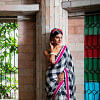Not an ordinary date on the calendar, Pahela Baishakh is characterised by vibrant festivities and mouth-watering dishes. For Bengali women, the essence of this day lies in their red and white sarees — an emblem of their unwavering love for tradition through the ages.
The classic red and white combination is not just about fashion. For most women, it is but a reflection of deep-rooted cultural symbolism. Red, the colour of passion, energy, and vitality, is believed to ward off evil spirits and bring good fortune. It signifies the vibrancy and dynamism of life itself. On the other hand, white represents purity, peace, and new beginnings. Together, these colours capture the essence of Pahela Baishakh, marking the transition from the old to the new with hope, optimism, and fervour.

For Bengali women, the red and white saree is a tradition passed down through generations. Many families have heirloom sarees that are worn specifically for Pahela Baishakh, carrying with them the memories of past celebrations and the anticipation of those yet to come. The meticulous craftsmanship, intricate designs, and fine fabrics make these sarees a treasured possession, to be worn with pride and reverence on this special day.
"My dadu loved sarees and over the years, she collected quite a few. Whenever I decide to brave the summer heat and wear a saree, I almost always take it from dadu's coffers. The combination is timeless," gushes Sameera Basu, a university student, in her third year of study.
The red and white saree serves as a unifying force, bringing together people from all walks of life to celebrate their shared heritage. The day is inclusive to Bengalis and non-Bengalis alike.
"Lacking a strong cultural connection during my childhood, I've come to cherish the significance of red and white in my adult life," expresses Hamida Saleh, a Communications Specialist who has spent most of her life outside Bangladesh. "The colours now serve as symbols of belonging to my community and heritage."
The red and white colour combination is versatile in that it has a brighter shade that makes the white pop. The red can be powerful or subdued, depending on the wearer's taste and the look can be styled in a number of different ways. For Adiba Ajanee, a businesswoman by profession, the red and white saree is all about tradition. "I'm wearing all white, with a red paar!" she announces.
Jewellery too, takes on a different sheen, when worn with this combination. From hand painted, earthen jewellery to beads, to statement necklaces and earrings, the sky is the limit for the red and white saree. "I'm going for a red saree with a white pearl necklace," says Hamida.
Those wanting to step up the jewellery game a little can also go for fresh flowers (flower garlands) for their hair and wrists. Others can opt for statement bangles to complete the look for their day. Either way, the quintessential Baishakhi combination is one that never disappoints, whichever look you decide to go for!








Comments